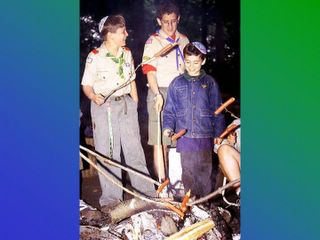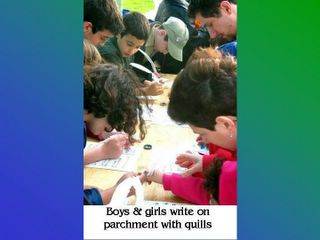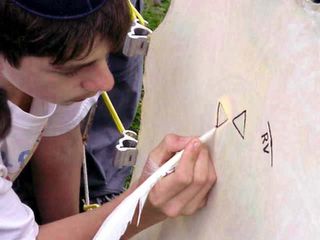Saturday, May 05, 2007

Join us for a fabulous family and young people's celebration of Lag Ba'Omer, located on the South Shore of Long Island, Nassau County, New York, RSVP to Alan Yanofsky- alyanofsky@email.com - Chairman of the Jewish Committee on Scouting, Theodore Roosevelt Council, Boy Scouts of America

Wednesday, May 02, 2007
Tuesday, May 01, 2007
What is Lag Ba'Omer
Lag Ba'Omer is a time of happy celebration, a day for weddings, picnics, and playfulness. It is observed by playing with toy bows and arrows, and celebrating around a bonfire with singing and dancing.
Lag Ba'Omer is a short way of saying "the 33rd day of counting of the Omer." The first word of the holiday's name, Lag, is simply a combination of two Hebrew letters, lamed (which stands for the number thirty) and gimmel (which stands for the number three). Thus thirty-three. The name of the holiday actually means the thirty-third day of the counting of the Omer. So what does counting the Omer mean?
It is unlikely that anyone knows how many days there are between New Year's Day and July 4th, or between Sukkot and Hanukka off the top of his head. But all religious Jews know that there are precisely fifty days between the second day of Passover and Shavuot. During the first forty-nine days of this period, known as the Omer, each day is counted aloud during the evening service.
In Hebrew, Omer means a sheaf of a harvested crop. (A sheaf is a tied bundle of cut stalks.) When the Temple stood in Jerusalem, priests would offer there, on behalf of all of Israel, newly harvested barley (an Omer, about 3.3 quarts) on the second day of Passover. Their doing so signaled the beginning of Israel's harvest season, a period that lasted seven weeks (forty-nine days). In the Torah, Shavout, which celebrates the giving of the Ten Commandments to Moses on Mount Sinai also celebrates the harvest's end on the fiftieth day after Passover. Thus the entire counting period becomes one of continuous elevation and preparation, from the status of an Egyptian slave to a person ready to receive the Torah.
Although one would think of the harvest period as joyous, in Jewish life the Omer is considered a time of semi-mourning. To this day, no scholar is sure why this is so. The Talmud speaks obscurely of a plague occurring on one Omer that killed 24,000 students of the second-century Rabbi Akiva. What kind of a plague was it that apparently only affected Rabbi Akiva's talmudic students and nobody else and came to an end on Lag Ba'Omer (the thirty-third of the forty-nine days)? Most modern scholars assume that the plague referred to was not an illness.
Rabbi Akiva supported a rebellion against the Roman conquerors of Israel led by a famous Jewish military leader by the name of Bar-Kochba. Moreover, Akiva declared Bar-Kochba to be the Messiah who would liberate the Jews from Roman domination. Although Bar-Kochba did achieve some early military successes, eventually the Romans suppressed his revolt with incredible brutality. Among Bar-Kochba's leading soldiers were thousands of Rabbi Akiva's students. Thus, it is likely that Lag Ba'Omer was a day on which the Jews either achieved a short lived victory over the Romans or gained some respite from the slaughter of battle.
So, the thirty-third day of the Omer, Lag Ba'Omer, is an exception to the semi-mourning. That day is a time of happy celebration, a day for weddings, picnics, and playfulness. It is observed by playing with toy bows and arrows, and celebrating around a bonfire with singing and dancing. Many Orthodox Jews give their three year old children their first haircut on Lag Ba'Omer and a party is held to celebrate the event. Lag Ba'Omer has always been a special day for school age children, so special that it was once the day when younger children could boss the older ones, who had to do as they were told. Lag Ba'Omer belongs to young people, it is your day.
Lag Ba'Omer is a short way of saying "the 33rd day of counting of the Omer." The first word of the holiday's name, Lag, is simply a combination of two Hebrew letters, lamed (which stands for the number thirty) and gimmel (which stands for the number three). Thus thirty-three. The name of the holiday actually means the thirty-third day of the counting of the Omer. So what does counting the Omer mean?
It is unlikely that anyone knows how many days there are between New Year's Day and July 4th, or between Sukkot and Hanukka off the top of his head. But all religious Jews know that there are precisely fifty days between the second day of Passover and Shavuot. During the first forty-nine days of this period, known as the Omer, each day is counted aloud during the evening service.
In Hebrew, Omer means a sheaf of a harvested crop. (A sheaf is a tied bundle of cut stalks.) When the Temple stood in Jerusalem, priests would offer there, on behalf of all of Israel, newly harvested barley (an Omer, about 3.3 quarts) on the second day of Passover. Their doing so signaled the beginning of Israel's harvest season, a period that lasted seven weeks (forty-nine days). In the Torah, Shavout, which celebrates the giving of the Ten Commandments to Moses on Mount Sinai also celebrates the harvest's end on the fiftieth day after Passover. Thus the entire counting period becomes one of continuous elevation and preparation, from the status of an Egyptian slave to a person ready to receive the Torah.
Although one would think of the harvest period as joyous, in Jewish life the Omer is considered a time of semi-mourning. To this day, no scholar is sure why this is so. The Talmud speaks obscurely of a plague occurring on one Omer that killed 24,000 students of the second-century Rabbi Akiva. What kind of a plague was it that apparently only affected Rabbi Akiva's talmudic students and nobody else and came to an end on Lag Ba'Omer (the thirty-third of the forty-nine days)? Most modern scholars assume that the plague referred to was not an illness.
Rabbi Akiva supported a rebellion against the Roman conquerors of Israel led by a famous Jewish military leader by the name of Bar-Kochba. Moreover, Akiva declared Bar-Kochba to be the Messiah who would liberate the Jews from Roman domination. Although Bar-Kochba did achieve some early military successes, eventually the Romans suppressed his revolt with incredible brutality. Among Bar-Kochba's leading soldiers were thousands of Rabbi Akiva's students. Thus, it is likely that Lag Ba'Omer was a day on which the Jews either achieved a short lived victory over the Romans or gained some respite from the slaughter of battle.
So, the thirty-third day of the Omer, Lag Ba'Omer, is an exception to the semi-mourning. That day is a time of happy celebration, a day for weddings, picnics, and playfulness. It is observed by playing with toy bows and arrows, and celebrating around a bonfire with singing and dancing. Many Orthodox Jews give their three year old children their first haircut on Lag Ba'Omer and a party is held to celebrate the event. Lag Ba'Omer has always been a special day for school age children, so special that it was once the day when younger children could boss the older ones, who had to do as they were told. Lag Ba'Omer belongs to young people, it is your day.








